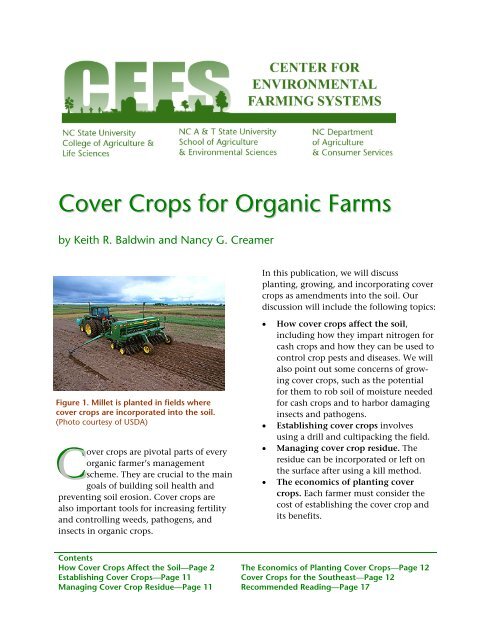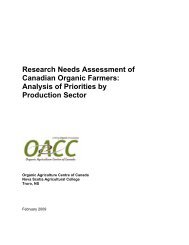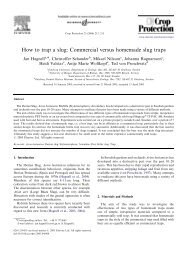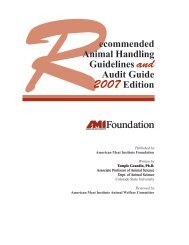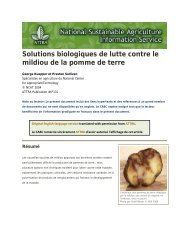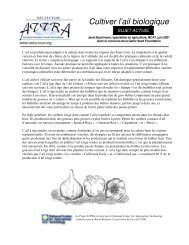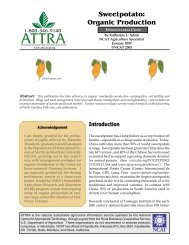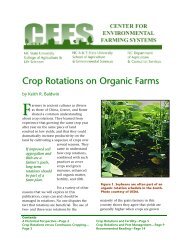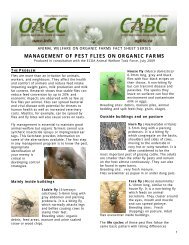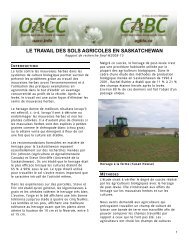Create successful ePaper yourself
Turn your PDF publications into a flip-book with our unique Google optimized e-Paper software.
• <strong>Cover</strong> crops <strong>for</strong> the Southeast. Wereview recommended winter andsummer cover crops and how they fitspecific cropping schemes.• Recommended resources <strong>for</strong> furtherstudy.HOW COVER CROPS AFFECT THESOILSoil ErosionThe best place to begin our discussion ofcover crops is to focus on how they help toreduce one of the most serious, persistentthreats to long-term farm productivity andthe environment—soil erosion. <strong>Cover</strong> cropsdo this partially by keeping the soil coveredduring rainy periods when it mightnormally be bare and subject to erosion byrainfall. Langdale et al. (1991) concludedthat cover crops reduced soil erosion by 62percent based on a comparison of bare soiland soil planted with a cover crop in thesoutheastern United States.Erosion decreases topsoil, and it also causessedimentation of our rivers, reservoirs, andestuaries. Sedimentation occurs whenrunoff from rainfall carries eroded soil anddeposits it into waterways. In time,sediment deposits produce losses of aquatichabitat that are extremely difficult toreverse. The short-term costs of soil erosioninclude nutrient losses in runoff from farmfields and negative impacts to the soil’sphysical structure.Soil scientists have estimated that the UnitedStates has lost 30 percent of its topsoil in thepast 200 years due to agricultural practicesthat leave bare, fallow soils <strong>for</strong> a significantportion of the year.(Tyler et al., 1994)How well do cover crops help to preventsoil erosion? During the fall, winter, andearly spring, this depends largely on whenthe cover crop is established. Timing isparticularly important in the fall becauselate planting of legume crops, such as hairyvetch, can result in poor stands and smallplants with limited root systems. If thecover crop is established early, however, itsvigorous fall growth protects soil andreduces erosion. Because of its rapid growthin fall and its continued growth duringwinter, cereal rye (Secale cereale) providesexcellent protection from erosion duringthe winter. The use of cover crops in no-tillsystems provides extended erosion controlbecause residue is left on the surface afterthe cover crop is killed and the subsequentcash crop is planted.How <strong>Cover</strong> <strong>Crops</strong> Improve the Soil• Increase soil organic matter throughadditions of plant biomass.• Form soil aggregates, which stabilize soiland reduce runoff and erosion.• Increase soil porosity and decrease soilbulk density to promote root growth.• Improve soil tilth, which reduces crustingand increases the rate of water infiltration.• Encourage populations of soil microbes,micro- and macro-arthropods andearthworms, all of which contribute toefficient nutrient cycling andimprovements in soil structure.Soil MoistureOne of the most important considerationsin growing cover crops is their impact onsoil moisture. During the summer months,cover crops left on the surface can help toconserve soil moisture by reducingevaporation from the surface and byincreasing water infiltration. However,<strong>Organic</strong> Production—<strong>Cover</strong> <strong>Crops</strong> <strong>for</strong> <strong>Organic</strong> <strong>Farms</strong> 2
grown too late in the spring, cover cropscan draw moisture down from the soil’supper layer, where it will be needed <strong>for</strong> seedgermination and stand establishment ofsubsequent cash crops.Thus, knowing when to kill and incorporatecover crops in the spring is abalancing act. The goal is to produce thegreatest possible amount of biomass, orliving matter, with the cover crop, whichmaximizes fertilizer values, while notdepleting soil moisture. Timing is everything.In early spring, while cover crops are stillactively growing, farmers should beginmonitoring soil moisture. During yearswith normal to dry weather patterns, thebest time to kill cover crops is usually twoweeks be<strong>for</strong>e planting cash crops(depending on weather <strong>for</strong>ecasts). Biomassyield and nitrogen (N) production bylegume cover crops may not be at theirmaximum levels at this point. However, inmost seasons, sufficient rainfall <strong>for</strong> adequatecrop emergence will occur during thetwo-week preplant period or within theweek immediately following planting. Inwet years or when a rainy period is <strong>for</strong>ecast,the cover crop can be killed immediatelybe<strong>for</strong>e soil preparation and planting ofspring crops.With these weather windows in mind, afarmer can create a plan to produce thehighest possible cover crop biomass andbiomass N yields. Studies show that whencover crop kill is delayed from early April toearly May, the yields of hairy vetch, cerealrye, and mixtures of both increase by anaverage of 160 percent in the Marylandpiedmont and by 83 percent in the coastalplain (Clark et al., 1994). In Clark’s study,the N contents of hairy vetch and hairyvetch-rye mixtures were 1.6 to 2 timesgreater at the late kill date: They rangedfrom 65 to 100 pounds N per acre <strong>for</strong> earlykill, and from 135 to 200 pounds N per acre<strong>for</strong> late kill. Based on those considerationsand by monitoring soil moisture and obtainingrainfall predictions, a farmer candecide on the best possible times <strong>for</strong> killingand incorporating a cover crop.Weed Management<strong>Cover</strong> crops and surface crop residues canbe used to control or inhibit weeds insubsequent cash crops in three basic ways:• By smothering and shading them sothey don’t receive adequate air andlight.• By outcompeting them <strong>for</strong> nutrients.• By producing an effect known asallelopathy, the toxic effect on weed seedgermination and seedling growth thatoccurs as residues of some cover cropsdecompose.The primary way to suppress weed seedgermination and growth is to have avigorous cover crop stand. Such a stand willsimply out-compete weed seeds <strong>for</strong> lightand nutrients (Teasdale and Daughtry,1993). When the cover crop is killed, itsthick residues remain on the surface andhinder weed growth by physicallymodifying the amount of natural light, soiltemperature, and soil moisture that isnecessary <strong>for</strong> weed seed germination.It’s important to note that suppressingweeds by smothering them becomes lesseffective as cover crop residues decompose.How fast residues decompose depends onseveral variables. For instance, warmtemperatures, rainfall, and field tillage canspeed up the decomposition rate. Anotherimportant factor is the C:N ratio, thecarbon-to-nitrogen ratio of different kindsof crop residues. Residues with a high C:Nratio, such as mature small grain cover<strong>Organic</strong> Production—<strong>Cover</strong> <strong>Crops</strong> <strong>for</strong> <strong>Organic</strong> <strong>Farms</strong> 3
crops like rye (which has a C:N ratio ofaround 50), have a much slower decompositionrate than legumes like hairy vetch(which has a C:N ratio of around 12). Mixturesof legumes and small grains have anintermediate rate of decomposition (a C:Nratio of around 25).<strong>Cover</strong> crop residues also interfere with weedemergence through the allelopathic effect(Creamer at al., 1996a). Scientists are stillresearching the many (and sometimesmysterious) allelopathic effects that oneplant has on another through its allelochemicals,the chemicals a plant releasesinto the environment that can be toxic toother plants. Some scientists believe thatthe specific allelopathic effects of certainplants are enhanced by chemicals producedby actinomycetes, algae, fungi, or othermicrobes associated with particular plantroot systems in the upper soil layers(Putnam, 1988). Where and how theseallelochemicals originate is often hard todiscern. Each chemical’s biological activitymay be reduced or enhanced by otherfactors, such as microbe action in the soiland oxidation. Other factors, such asenvironmental conditions, insects, ordisease pressure, can speed up thedetrimental effects of allelochemicals onweeds.In one study, researchers found that cerealrye residues on the soil surface suppressedmost common annual broadleaf and grassyweeds <strong>for</strong> four to eight weeks (Smeda andWeller, 1996). Thus, using a rye cover cropcould eliminate the need <strong>for</strong> a soil-appliedherbicide at transplanting withoutdepressing yield. The authors indicated,however, that post-emergence weed controlof escaped weeds might be necessary insome years.Researchers have reported that the covercrops listed in Table 1 have shownallelopathic effects on certain weeds. Weshould note that the allelopathic effects ofcrimson clover and hairy vetch are moreapparent if the cover crop is incorporatedrather than left on the surface in no-tillmanagement (Teasdale and Daughtry,1993).Table 1. A summary of research on the allelopathic effects of cover cropsInvestigator and<strong>Cover</strong> CropWeeds SuppressedPublication DateHairy vetchLambsquarters, yellow foxtail,yellow nutsedge,Teasdale et al., 1993White et al., 1989pitted morninggloryCrimson clover Pitted morningglory, wild mustard,Italian ryegrassTeasdale et al., 1993White et al., 1989Cereal ryeLambsquarters, redroot pigweed,common ragweedBarnes and Putnam, 1986Schilling et al., 1985Masiunas, 1995Wheat Morningglory, prickly sida Liebl and Worsham, 1983Velvetbean Yellow nutsedge, chickweed Hepperly et al., 1992Fujii et al., 1992Sorghum sudangrass Annual ryegrass Forney and Foy, 1985<strong>Organic</strong> Production—<strong>Cover</strong> <strong>Crops</strong> <strong>for</strong> <strong>Organic</strong> <strong>Farms</strong> 4
Disease ManagementThe impact of cover crops on pathogens—agents in the soil, such as bacteria orviruses, that cause disease—can be good,bad, or nonexistent. This impact variesbroadly depending on individual circumstancesand situations. A cover crop can actas a host <strong>for</strong> soilborne pathogens, or it canserve as an effective <strong>for</strong>m of biologicalcontrol <strong>for</strong> other plant pathogens.Incorporating cover crop residues can, insome cases, provide an organic food basethat encourages pathogen growth (Phillipset al., 1971). On the other hand, somecover crops, such as brassicas (cabbage andmustard), can actually decrease soilpathogen populations (Lewis and Papavizas,1971; Subbarao and Hubbard, 1996).The impact of a cover crop on a pathogeninvolves many variables. Principally, itdepends upon the pathogen’s nature andlife cycle requirements. For example, if thepathogen survives best on surface residueand the cover crop residue is left on the soilsurface as mulch, then the pathogen maysurvive until the next crop is planted andthe level of disease may increase (Fawcett,1987). Many plant diseases are associatedwith surface residue, <strong>for</strong> example, fungaland bacterial leaf blights (Boosalis andCook, 1973).At the same time, the increases in soilorganic matter provided by cover crops canenhance biological control of soilborneplant pathogens. This comes about boththrough direct antagonism and bycompetition <strong>for</strong> available energy, water,and nutrients (Sumner et al., 1986).Organisms that cause disease can also beaffected by changes in temperature,moisture, soil compaction, and bulkdensity, as well as nutrient dynamics.Whether or not the cover crop is in thesame family of plants (taxonomicallyrelated) to the subsequent cash crop canalso influence whether or not disease cyclesare interrupted or prolonged.Nematode ManagementNematodes are enough of a concern in thesandy soils of the southeastern U. S. to givethem individual attention when consideringdisease management. The root-knotnematode (Meloidogyne spp.) is particularlytroublesome in the Southeast. Agriculturalscientists have more questions thananswers concerning how to reduce populationsof nematodes with cover crops.They are struggling to find a selection ofcrop rotations with cover crops that canaddress a wide variety of nematodes thathave a very diverse host range (Reddy et al.,1986). They are also unclear, at this point,as to how some cover crops reduce thepopulation levels of certain nematodespecies.Examples of Nematode-Control Successwith Warm-Season LegumesWarm season legume cover crops are effectivein reducing populations of some plantparasiticnematodes:• Rhoades and Forbes (1986) reported thathairy indigo and joint vetch cover crops(coupled by mulching with clippings ofcowpea) were highly effective <strong>for</strong>maintaining low populations of B.longicaudatus and M. incognitanematodes.• Rodriguez-Kabana et al. (1992) reportedthat velvetbean was effective in loweringpopulation densities of several root-knotspecies (present simultaneously) ingreenhouse and field tests. Un<strong>for</strong>tunately,this is not always the case in field tests.<strong>Organic</strong> Production—<strong>Cover</strong> <strong>Crops</strong> <strong>for</strong> <strong>Organic</strong> <strong>Farms</strong> 5
For instance, some green manure or covercrops placed in a rotation can reducedamage by one nematode species but notothers. In a study in Florida, the warmseasonlegumes, which included pigeonpea,crotalaria, hairy indigo, velvetbean, andjoint vetch, reduced root-knot nematodedamage in a subsequent snapbean cropwhen the crop was compared to oneproduced in fallow. These same cover crops,however, were no more effective thanfallow in reducing damage from sting(Belonolaimus longicaudatus) and lesion(Pratylenchus brachyurus) nematodes.In some cases, a cover crop can reducepopulations of one parasitic nematode butserve as a host that increases populations ofother nematodes. While two researchers(McSorley and Gallaher) reported in 1991that sorghum-sudangrass cover cropsreduced levels of root- knot nematodes,Rhoades and Forbes (1986) found that asorghum-sudangrass cover crop increasedpopulations of B. longicaudatus and M.incognita nematodes. Farmers attempting touse crop rotations <strong>for</strong> controlling onenematode species must be aware that theserotations could benefit other damagingnematodes present in the field (McSorleyand Dickson, 1995). Potential rotationcrops should be evaluated <strong>for</strong> their effectson as many different damaging nematodesas possible.<strong>Cover</strong> Crop Tip<strong>Organic</strong> growers commonly plant rapeseed,mustard, and other brassicas as rotation cropsto “clean-up” soil during winter months.These plants have been shown to suppress awide range of parasitic nematodes.(Bending and Lincoln, 1999)Insect Management<strong>Cover</strong> crops can be both a blessing and adrawback because they attract bothbeneficial and harmful insects to farm fields(Altieri and Letourneau, 1982; Andow,1988). When a cover crop matures or dies,both the beneficial and pest insects maymove to cash crops. The resulting effect oninsect pest populations on the farm (aneffect that also depends on severalenvironmental factors) can presentfrustrating dilemmas <strong>for</strong> a farmer. Forexample, in a study in 1991, researchersfound that a rye cover crop helped toreduce fruitworm populations in thetomato crop that followed it. But the ryecover also led to increased stinkbug damage(Roberts and Cartwright, 1991).To create the best situation, a farmer growsa cover crop to attract beneficial insectsbe<strong>for</strong>e the damaging insects arrive. Thebeneficial insects are attracted by themoisture, shelter, pollen, honeydew, nectar,and potential insect prey associated withthe cover crop. These beneficial insectssubsist in the cover crop and then moveinto the vegetable crop to attack arrivingpest insects. Several studies show that thisapproach is often successful. Researchers inGeorgia reported high densities of big-eyedbugs, lady beetles, and other beneficialinsects in vetches and clovers that movedinto ensuing tomato crops (Bugg et al.,1990). In a more recent study, a researcherreported that assassin bugs destroyedColorado potato beetles feeding oneggplant that had been planted into striptilledcrimson clover (Phatak, 1998).<strong>Organic</strong> Production—<strong>Cover</strong> <strong>Crops</strong> <strong>for</strong> <strong>Organic</strong> <strong>Farms</strong> 6
Nitrogen FixationOne of the most significant contributionsthat legume cover crops make to the soil isthe nitrogen (N) they contain. Legumecover crops fix atmospheric N in their planttissues in a symbiotic or mutually beneficialrelationship with rhizobium bacteria. Inassociation with legume roots, the bacteriaconvert atmospheric N into a <strong>for</strong>m thatplants can use. As cover crop biomassdecomposes, these nutrients are released <strong>for</strong>use by cash crops. Farmers should make anef<strong>for</strong>t to understand this complex processbecause it will help them to select theproper legumes <strong>for</strong> their cropping plan,calculate when to incorporate cover cropsand plant cash crops that follow, and planfertilizer rates and schedules <strong>for</strong> those cashcrops. Above all, they need to inoculatelegume seed be<strong>for</strong>e planting with theappropriate Rhizobium species.<strong>Cover</strong> Crop TipNonleguminous cover crops, typically grassesor small grains, do not fix nitrogen. Nonetheless,they can be effective in recovering mineralizednitrogen from soil after crops areharvested.The N associated with cover crop biomassundergoes many processes be<strong>for</strong>e it is readyto be taken up <strong>for</strong> use by cash crops. Theprocess begins with biomass N, which is thenitrogen contained in mature cover crops.From 75 to 90 percent of the nitrogencontent in legume cover crops is containedin the aboveground portions of the plant,with the remaining N in its roots andnodules (Shipley et al., 1992).When legume or grass cover crops are killedand incorporated into the soil, livingmicroorganisms in the soil go to work todecompose plant residues. The biomassnitrogen is mineralized and converted firstto ammonium (NH 4) and then to nitratecompounds (NO 3) that plant roots can takeup and use. The rate of this mineralizationprocess depends largely on the chemicalcomposition of the plant residues that areinvolved (Clement et al., 1995), and onclimatic conditions.Determining the ratio of carbon to nitrogen(C:N) in the cover crop biomass is the mostcommon way to estimate how quicklybiomass N will be mineralized and released<strong>for</strong> use by cash crops. As a general rule,cover crop residues with C:N ratios lowerthan 25:1 will release N quickly. In thesoutheastern U. S., legume cover crops,such as hairy vetch and crimson clover,killed immediately be<strong>for</strong>e corn plantinggenerally have C:N ratios of 10:1 to 20:1(Ranells and Wagger, 1997). Residues withC:N ratios greater than 25:1, such as cerealrye and wheat, decompose more slowly andtheir N is more slowly released.A study conducted in 1989 reported that 75to 80 percent of the biomass N produced byhairy vetch and crimson clover residues wasreleased eight weeks after the cover cropswere incorporated into the soil (Wagger,1989a). This amounted to 71 to 85 poundsof N per acre. However, not all of thereleased N was taken up by the subsequentcorn crop. The corn utilized approximately50 percent of the N released by bothresidues. (This value may be con-sidered theN uptake efficiency of corn from legumeresidues. This value is similar to the Nuptake efficiency of corn from inorganicfertilizer sources, such as ammoniumnitrate.) The N not taken up by the followingcrops may still contribute to soil health.Living microbes in the soil may use thenitrogen to support population growth andmicrobial activity in the soil.<strong>Organic</strong> Production—<strong>Cover</strong> <strong>Crops</strong> <strong>for</strong> <strong>Organic</strong> <strong>Farms</strong> 7
As with just about everything else when itcomes to farming, the practice of growingcover crops to produce nitrogen in the soilis complicated by many variables. Weather,differences in growing seasons, the types ofcover crops involved, and the timing ofcover crop desiccation to produce the optimumbenefit all come into play. Amassingexperience in cover crop production issimply the best way <strong>for</strong> a farmer to learnhow to deal with the interplay of all thesevariables.Legumes Versus Grasses. As we’veseen above, legume cover crops play a vitalrole in producing N <strong>for</strong> subsequent cashcrops. What part do nonleguminous covercrops, which do not produce nitrogen, havein the cropping scheme?<strong>Organic</strong> farmers often plant nonleguminouswinter cover crops to trap the soil Nthat is left over from summer cash cropsand to prevent this N from leaching out ofthe root zone or running off the field.Generally, grass cover crops are veryeffective—much more so than legumes—intrapping and recovering N from the soil.Grass and legume cover crop mixtures aremore efficient than legumes alone intrapping leftover N in the soil, but don’t doas effective a job as straight grass covercrops.There are many advantages, however, toplanting cover crops that are grass andlegume mixtures called bicultures.Researchers (Clark et al., 1994) reportedthat a cereal rye-hairy vetch biculturesuccessfully scavenged potentially leachableN from the soil, and also added fixed N<strong>for</strong> use by an ensuing corn crop. Additionally,the cover crop used excess water inthe soil, which also helped limit N leachinglosses.Grass species establish ground cover morequickly than legume monocultures, andtheir root growth remains active in thecooler temperatures of autumn (Ranells andWagger, 1997). <strong>Cover</strong> crop mixtures thatinclude grasses can, there<strong>for</strong>e, prevent soilerosion more effectively. Growing deeprootedand shallow-rooted cover cropstogether will also help a farmer to makebetter use of water and other resourcesthroughout the soil profile.Legumes or Grasses? How To Choose a<strong>Cover</strong> CropGenerally, cover crop selection is based oneach farmer’s situation and production goals.For example, if the purpose of a cover is toprovide readily available, biologically fixednitrogen <strong>for</strong> cash crops, then the farmershould choose a legume, such as hairy vetchor cowpea.If the cover crop will be managed as a surfacemulch <strong>for</strong> weed suppression or incorporatedto improve soil quality, then the farmer shouldchoose a grass cover crop, such as cereal ryeor a sorghum-sudangrass mix. Both of thesegrass cover crops can produce large amountsof biomass with high C:N ratios at maturity,and both are reported to suppress someweeds.Farmers can also more effectivelymanipulate nitrogen cycling with mixedcover crop species. Combining maturecereals, which have high carbon to nitrogen(C:N) ratios and break down slowly,with legumes, which have low C:N ratiosand break down more quickly, can influencedecomposition of cover crop residues.The decomposition of such cover cropmixtures will occur more quickly than thatof cereal alone, releasing N more quickly <strong>for</strong>uptake by cash crops.<strong>Organic</strong> Production—<strong>Cover</strong> <strong>Crops</strong> <strong>for</strong> <strong>Organic</strong> <strong>Farms</strong> 8
Planting mixtures of cover crops can help afarmer to use the allelopathic potential ofthe cover crops to suppress weeds. Allelopathicsuppression of weeds depends onboth the cover crop and the weed. There<strong>for</strong>e,a broader spectrum of weed controlmay be possible by growing a mixture ofcover crops, with each species contributingallelopathic activity towards specific weedspecies (Creamer and Bennett, 1997).Mixtures of cover crops can also be plantedto influence insect populations. Species thatmay not produce much biomass or biomassN may be included in mixtures to attractbeneficial insects into the cropping system.Measuring <strong>Cover</strong> Crop Nitrogen. Toensure that cash crops receive enoughnutrients, farmers must accomplish thesecalculations in this sequence:1. Determine the biomass produced.2. Determine the nutrient levels in thatbiomass.3. Predict how quickly the biomass willdecompose, releasing nutrients <strong>for</strong> cashcrops.4. Calculate whether additional nutrientsare required <strong>for</strong> the desired crop yields.<strong>Cover</strong> Crop TipCalculating the nutrient levels released bygreen manures <strong>for</strong> a subsequent cash cropnormally requires three measurements:• The amount of biomass (dry weight).• The nutrient composition of the covercrop.• The decomposition rate of the cover cropduring the cash cropping season.To estimate yield, take cuttings from severalareas in the field. Dry and weigh the samples.Use a yardstick or metal frame of knowndimensions and clip the plants at ground levelwithin the known area. Dry the samples in anoven at about 140°F <strong>for</strong> 24 to 48 hours untilthey are crunchy dry. Use the followingequation to determine per acre yield of drymatter:Yield (lb/acre) =Total weight of dried samples (lb) X43,560 sq ftArea (sq ft) sampled 1 acreFor example, two 3 feet by 3 feet (9 sq ft or 1 sqyd) samples weigh 2.5 pounds. The driedbiomass yield equals:Yield (lb/acre) =2.5 lbX43,560 sq ft = 6,050 lb/acre.18 sq ft 1 acreThough not as accurate, yield can be estimatedfrom the height of the cover crop and thepercentage of ground it covers. At 100 percentground coverage and a 6-inch height, mostnonwoody legumes contain roughly 2,000pounds per acre of dry matter. For each additionalinch, add 150 pounds.For example, a hairy vetch cover crop is 18inches tall and has 100 percent groundcoverage. The first 6 inches of dry biomassweighs roughly 2,000 pounds. The 12additional inches of growth weighs 150 poundsper inch. The additional weight is:12 X 150 = 1,800 lb,and the total weight of the cover crop drymatter is:2,000 + 1,800 = 3,800 lbIf the stand has less than 100 percent groundcoverage, multiply the total weight by thepercentage of ground covered, represented as adecimal number (the percentage divided by100). If the percentage of ground covered in theexample above is 60 percent, then the weightof the dry matter is:3,800 X 0.60 (60/100) = 2,280 pounds of drybiomass (Adapted from Sarrantonio, 1998)<strong>Organic</strong> Production—<strong>Cover</strong> <strong>Crops</strong> <strong>for</strong> <strong>Organic</strong> <strong>Farms</strong> 9
These calculations normally require threemeasurements: the amount of biomass (dryweight), the nutrient composition of thecover crop, and the decomposition rate ofthe cover crop during the cash croppingseason.Farmers can estimate the amount ofnitrogen in a cover crop by estimating thetotal biomass yield of the cover crop andthe percentage of nitrogen in the plantswhen they’re killed. A simple process <strong>for</strong>the assessment is explained in Managing<strong>Cover</strong> <strong>Crops</strong> Profitably (Sarrantonio, 1998:For cereal rye, the height relationship is abit different. Cereal rye produces approximately2,000 pounds per acre of dry matterat an 8-inch height and 100 percent groundcoverage. For each additional inch, add 150pounds, as be<strong>for</strong>e, and multiply by thepercentage of ground covered, representedas a decimal (the percentage dividedby100). For most small grains and otherannual grasses, start with 2,000 pounds peracre at a 6-inch height and 100 percent ofground covered. Add 300 pounds <strong>for</strong> eachadditional inch, and multiply by the percentageof ground covered, represented as adecimal (the percentage divided by 100).To calculate the amount of nitrogen in the driedcover crop biomass, multiply the dry biomassyield times the percentage of nitrogen expressedas a decimal (percentage of N divided by 100).For the hairy vetch cover crop example abovewith 100 percent cover and an estimated 4percent nitrogen at flowering:Total N (lb/acre) = 3,800 lb/acre X .04 (4 ÷ 100)= 152 lb N per acreAnnual legumes typically have between 3.5and 4.0 percent nitrogen in the abovegroundbiomass prior to flowering, and 3.0to 3.5 percent at flowering. After flowering,nitrogen in the leaves decreases quickly as itaccumulates in the growing seeds. Mostcover crop grasses contain 2.0 to 3.0 percentnitrogen be<strong>for</strong>e flowering and 1.5 to2.5 percent after flowering. Other covercrops, such as Brassica species and buckwheat,will generally be similar to, orslightly below, grasses in their N concentration.To precisely determine the percentageof nitrogen in the cover crop, senda plant sample to a laboratory <strong>for</strong> a chemicalanalysis. The N.C. Department of AgriculturePlant Analysis Lab provides thatservice <strong>for</strong> $4 per sample.As discussed previously, not all of thenitrogen contained in the cover cropresidue will be available to the cash crop.To conservatively estimate the amount thatwill be available to the following crop,multiply legume biomass nitrogen, ascalculated above, by 0.50 if the cover cropresidue will be incorporated and by 0.40 ifthe residue will be left on the soil surface.From the example above, if the hairy vetch isincorporated in the soil in early May in a normalspring, then the nitrogen available from thehairy vetch to the cash crop will be:Available N (lb/acre) =152 lb N per acre X .50 = 76 lb N per acre.If the hairy vetch is left on the soil surface inearly May in a normal spring, then the nitrogenavailable from the hairy vetch to the next cropwill be:Available N (lb/acre) =152 lb N per acre X .40 = 61 lb N per acreThese availability coefficients will change,depending on the weather. In dry or cold<strong>Organic</strong> Production—<strong>Cover</strong> <strong>Crops</strong> <strong>for</strong> <strong>Organic</strong> <strong>Farms</strong> 10
Recommended Winter SpeciesExamples of winter legume cover cropsinclude crimson clover, hairy vetch,Austrian winter pea (Pisum sativum arvense),and subterranean clover (Trifolium subterraneum).Cereal rye, wheat, and oats are alsocommonly used as small grain cover cropsand in mixtures with the legumesmentioned above. Generally, winter covercrops are planted in early fall and allowedto grow until mid-spring, at which time thecrop is incorporated by tillage, or killed andleft as a surface mulch into which anothercrop is planted.Winter LegumesClover, Vetch & Winter Peas—What AreTheir Limitations?Hairy vetch tends to be more winter hardythan the other winter legumes and cangenerally be planted later in the season. Hairyvetch also adapts better to sandy soils thancrimson clover, although crimson clover willprovide adequate dry matter production onmost well-drained, sandy loams.In contrast, crimson clover grows faster in thespring, thereby maturing and obtaining peakdry matter production approximately three tofour weeks be<strong>for</strong>e hairy vetch. Adequate drymatter and nitrogen production will beobtained with a soil pH from 5.8 to 6.0. Soiltesting will help determine P and K fertilizerrequirements. It is important to inoculatelegumes with the proper strain of N-fixingbacteria.Hairy vetch (Vicia villosa). Hairy vetch<strong>for</strong>ms a very dense cover and, if plantedwith a tall growing species like rye, willclimb and produce a great deal of biomass.Hairy vetch is probably the mostcommonly used cover crop in the UnitedStates, in part because it is so widelyadapted. Hairy vetch is seeded at 20 to 30pounds per acre, with the lower rate used ifthe vetch is drilled or planted in mixtures.At mid-bloom, hairy vetch can be easilykilled by undercutting or mowing. Be awarethat hairy vetch can harbor root-knotnematodes (Meloidogyne spp.), soybean cyst(Heterodera glycines), and various cutworms.Susceptible vegetable crops should betemporarily separated in a rotation. Ifallowed to produce mature seed, vetch canalso be viewed as a weed in subsequentsmall grain crops.Crimson clover (Trifolium incarnatum).Crimson clover stands upright and bloomsabout three to four weeks earlier than hairyvetch. It grows vigorously in fall and winterand has good reseeding ability. It is notwidely adapted, however, and is moreappropriate in warmer climates. Crimsonclover has good shade tolerance and can beoverseeded into fall vegetable crops inSeptember. Seeding rates vary from 15 to 25pounds per acre, with the lower rate beingused when the seed is drilled.Subterranean clover (Trifoliumsubterraneum). Subterranean clover is arelatively low growing winter annual withprostrate stems. In late spring, subterraneanclover develops seeds below ground(much like peanuts), which gives it anexcellent reseeding ability. Subterraneanclover <strong>for</strong>ms a thick mat when left on thesurface as a mulch and has been shown tosuppress weeds in vegetable crops plantedinto the mulch. Subterranean clover doesnot produce as much biomass as other coolseasonlegumes grown in the South, butbiomass yield can reach 5,500 pounds peracre with a nitrogen concentration ofbetween 2 and 3 percent. Subterranean<strong>Organic</strong> Production—<strong>Cover</strong> <strong>Crops</strong> <strong>for</strong> <strong>Organic</strong> <strong>Farms</strong> 13
clover is seeded at 8 to 15 pounds per acrebetween mid-September and mid-October.Austrian winter pea (Pisum sativumarvense). Austrian winter pea is succulentand viney and can climb when plantedwith small grain crops. It grows vigorouslyand will suppress weeds while growing, butit decomposes rapidly and is not a goodchoice <strong>for</strong> a surface mulch and weedcontrol. Austrian winter pea does well in amixture with oats, barley, rye, or wheat.Seed is drilled at 60 to 90 pounds per acreand can be sown through October.Winter NonlegumesCereal rye (Secale cereale). Rye is one ofthe most commonly used winter covercrops. It grows 3 to 6 feet tall and has anextensive, fibrous root system. It per<strong>for</strong>mswell when mixed with hairy vetch, whichwill use it <strong>for</strong> climbing support. Rye cantolerate a wide variety of soil types andclimatic conditions and is considered to beweed suppressive when managed as amulch. Of all the small grains, rye is thebest scavenger of excess soil nitrogen in thefall. The seeding rate is 100 pounds peracre.Annual ryegrass (Lolium multiflorum).Annual ryegrass is a noncreepingbunchgrass. In the spring it can grow 2 to 4feet tall. Annual ryegrass can be difficult tocontrol and can become a serious weed if itproduces seed. Ryegrass requiresconsiderable nitrogen and water. If theseare limited, it may not be a good choice.Ryegrass has a very fibrous, dense rootsystem that protects against soil erosionwhile improving water infiltration and soiltilth. Dry matter yield can average between1,300 and 2,000 pounds per acre, with anaverage nitrogen content of 1.5 percent.Normally seeded in the fall, seeding ratesare between 20 and 30 pounds per acre.Other cereal grasses. All of the cerealgrasses will produce biomass ranging from2,000 to 6,000 pounds per acre withnitrogen concentrations between 1 and 2percent. Biomass accumulation depends, inpart, on how early in the spring the covercrop is killed. The high end of the rangerepresents a kill date in mid- to late May. Atthis late date, however, the biomass carbonto nitrogen (C:N) ratio will normally begreater than 50:1, a ratio at which soilmicrobes would immobilize anymineralized nitrogen. Small grains arenormally drilled at 100 pounds of seed peracre.• Wheat (Triticum aestivum) provides agood overwintering ground cover andalso provides the option of harvestingthe grain.• Barley (Hordeum vulgare) biomassproduction peaks about two weeksearlier than wheat, and about the sametime as crimson clover. Barley, grown asa smother crop, has been shown tosuppress winter annual weeds incropping systems, but must be plantedin September or early October to reducewinter kill.• Oats (Avena sativa) grow well in coolweather and provide rapid ground coverin the fall. Some growers plant springoats in the fall to produce a winterkilledmulch <strong>for</strong> early spring no-tillvegetable plantings. However, springoats may not always winter-kill in mildwinters.Recommended Summer SpeciesThere is growing interest in the use ofshort-season summer annual legumes orgrasses as cover crops and green manures incropping systems. Summer annual legumes<strong>Organic</strong> Production—<strong>Cover</strong> <strong>Crops</strong> <strong>for</strong> <strong>Organic</strong> <strong>Farms</strong> 14
and grasses can provide benefits betweenthe harvest of spring vegetable crops andthe planting of fall vegetables or smallgrains. While additional legumes andgrasses are being evaluated <strong>for</strong> use, thefollowing species are currently the bestoptions.Summer LegumesCowpea (Vigna unguiculata). Othercommon names <strong>for</strong> this species areblackeyed, crowder, and southern pea.Cowpea is a fast growing, summer covercrop that adapts to a wide range of soilconditions. Cowpeas have a deep taproot,tolerate drought, and compete well againstweeds. Cowpeas produce 3,000 to 4,000pounds of dry biomass per acre, whichcontains 3 to 4 percent nitrogen. Maximumbiomass is achieved in 60 to 90 days.Residues are succulent and decomposereadily when incorporated into the soil.Cowpeas can be planted in the spring (afterall danger of frost) through late summer.Cowpea seeds can be drilled in rows 6 to 8inches apart at 40 pounds per acre or broadcastat approximately 75 pounds per acre.Higher seeding rates are necessary in latesummer when soil moisture is likely to belimited. Recommended cultivars includeIron Clay and Red Ripper. Plants normallygrow up to 24 inches tall, but some cultivarscan climb when planted in mixtureswith other species. Good mixture optionsare sorghum-sudangrass and Germanfoxtail millet. When mowed or undercut,cowpeas have the potential <strong>for</strong> considerableregrowth in some years.Soybean (Glycine max). Soybean is one ofthe most economical choices <strong>for</strong> a summerlegume cover crop. It is an erect, bushyplant that grows 2 to 4 feet tall, establishesquickly, and competes well with weeds.When grown as a green manure crop, latematuring cultivars usually give the highestbiomass yield and fix the most nitrogen. Ifwell established, soybean will withstandshort periods of drought. The viney, <strong>for</strong>agetypes (<strong>for</strong> example, the cultivars Quailhavenand Laredo) have the potential toproduce more biomass than traditionalsoybean cultivars.Velvetbean (Mucuna deeringiana).Velvetbean is a vigorously growing, warmseasonannual legume native to the tropicsand well adapted to southern U. S. conditions.It per<strong>for</strong>ms well in sandy and infertilesoils. Most cultivars are viney, andstems can grow as much as 10 meters.Velvetbean is an excellent green manurecrop, producing high amounts of biomassthat decompose readily to provide nitrogen<strong>for</strong> a cash crop. Velvetbean does best whendirect-seeded into warm soils in 38-inchrows. Velvetbean seed should not bedrilled, because the very large seed can bedamaged in conventional drills.Sunnhemp (Crotalaria juncea). Sunnhempis a tall, herbaceous, warm-season annuallegume with erect fibrous stems. It has beenused extensively <strong>for</strong> soil improvement andgreen manuring in the tropics. It competeswith weeds, grows rapidly, and can reach aheight of 8 feet in 60 days. It can toleratepoor, sandy soils and drought, but requiresgood drainage. Sunnhemp toleratesmoderate acidity, but a soil pH below 5 canlimit growth. Sunnhemp should be drilledor seeded in rows 38 inches apart at 30pounds per acre. The growing season in thecontinental U.S. is not long enough toproduce viable seed. Sunnhemp becomesfibrous with age, but the plants aresucculent <strong>for</strong> about eight weeks afterseeding. Sunnhemp is often planted inmidsummer after cool-season vegetables orsweet corn crops are harvested. It willproduce high biomass and biomass<strong>Organic</strong> Production—<strong>Cover</strong> <strong>Crops</strong> <strong>for</strong> <strong>Organic</strong> <strong>Farms</strong> 15
nitrogen in 45 to 60 days. Seed is notreadily available at this writing in early2006, but availability may increase ifdemand increases. While some Crotalariaspecies are toxic to animals, sunnhemp<strong>for</strong>age is not. Sunnhemp should not to beconfused with showy crotalaria, a noxiousweed species.Summer NonlegumesBuckwheat (Fagopyrum esculentum).Buckwheat is a very rapidly growingbroadleaf summer annual, which canflower in four to six weeks. It reaches 30inches in height and is single-stemmedwith many lateral branches. It has both adeep taproot and fibrous roots. It can begrown to maturity between spring and fallvegetable crops, suppressing weed growthand recycling nutrients during that period.It is succulent, easy to incorporate, anddecomposes rapidly. Buckwheat flowers arevery attractive to insects, and some farmersuse this cover to attract beneficial insectsinto cropping systems. Buckwheat is aneffective phosphorous scavenger. The maindisadvantage to buckwheat is that it setsseed quickly and, if allowed to go to seed,may become a weed in cash crops. Thus,the optimal time to incorporate buckwheatis one week after flowering, be<strong>for</strong>e seed isset. Buckwheat can be planted anytime inthe spring, summer, or fall, but is frostsensitive.Sorghum sudangrass (Sorghum bicolor ×Sorghum sudanense). Sorghum sudangrass isa hybrid of grain sorghum and sudangrass.It is a warm-season annual grass, most oftenplanted from late spring through midsummer.It grows well in hot, dryconditions and produces a large amount ofbiomass. Often reaching 6 feet in height, itcan be mowed to enhance biomassproduction. Sorghum sudangrass is veryeffective at suppressing weeds and has beenshown to have allelopathic properties. Theroots of sorghum sudangrass are good<strong>for</strong>agers <strong>for</strong> nutrients and help controlerosion. Sorghum sudangrass does wellwhen planted in mixtures, providingeffective support <strong>for</strong> viney legumes likevelvetbean. If frost-killed, the residue canprovide a no-till mulch <strong>for</strong> early plantedspring crops like broccoli. When stressed bydrought or by frost, this cover crop canproduce prussic acid, which is toxic tocattle.German (foxtail) millet (Setariaitalica). German or foxtail millet is anannual warm-season grass that maturesquickly in the hot summer months. It isone of the oldest of cultivated crops.German millet has a fairly low waterrequirement. Because of its shallow rootsystem, however, it doesn’t recover easilyafter a drought. Grain <strong>for</strong>mation requires75 to 90 days. German millet <strong>for</strong>ms slender,erect, and leafy stems that can vary inheight from 2 to 4 feet. The seed can bedrilled from mid-May through August at arate of 10 to 15 pounds per acre. A smallseeded crop, German millet requires arelatively fine, firm seedbed <strong>for</strong> adequategermination. To avoid early competitionfrom germinating weed seed, it should beclosely drilled in the row or sown in a staleseedbed—a seedbed that has been prepared,with early emerged weeds killed just be<strong>for</strong>eplanting the cover crop. Coarse, sandy soilsshould be avoided.Pearl millet (Pennisetum glaucum). Pearlmillet is a tall annual bunchgrass thatgrows 4 to 10 feet tall. It is also oftenreferred to as cattail millet because its long,dense, spike-like inflorescences resemblecattails. Though it per<strong>for</strong>ms best in sandyloam soils, pearl millet is well adapted tosoils that are sandy, infertile, or both. Pearl<strong>Organic</strong> Production—<strong>Cover</strong> <strong>Crops</strong> <strong>for</strong> <strong>Organic</strong> <strong>Farms</strong> 16
millet can be planted from late Aprilthrough July at a rate of 15 to 20 poundsper acre. Pearl millet matures in 60 to 70days. In North Carolina studies, pearl milletwas not as readily killed by mechanicalmethods (mowing and undercutting) asGerman or Japanese millet.Japanese millet (Enchinochloa frumentacea).Japanese millet is an annual grassthat grows 2 to 4 feet tall. It resembles andmay have originated from barnyard grass.Japanese millet is commonly grown as alate-season green <strong>for</strong>age. If weatherconditions are favorable, it grows rapidlyand will mature from seed in as little as 45days. Japanese millet can be planted fromApril to July at a rate of 10 to 15 pounds peracre. It per<strong>for</strong>ms poorly on sandy soils.RECOMMENDED READINGSources CitedAltieri, M.A., and D.K. Letourneau. 1982.Vegetation management and biologicalcontrol in agroecosystems. Crop Protection.1:405-430.Andow, D.A. 1988. Management of weeds <strong>for</strong>insect manipulation in agroecosystems. InM.A. Altieri and M. Liebman (Eds.). WeedManagement in Agroecosystems: EcologicalApproaches. pp.265-294. CRC Press. BocaRaton, FL.Allison, J.R., and S.L. Ott. 1987. Economics ofusing legumes as a nitrogen source inconservation tillage systems. In (J.F.Power, Ed.) The Role of Legumes inConservation Tillage Systems. pp.145-150.Soil Conservation Society of America.Barnes, J.P., and A.R. Putnam. 1986. Evidence<strong>for</strong> allelopathy by residues and aqueousextracts of rye (Secale cereale). WeedScience. 86:384-390.Bending G.D., and S.D. Lincoln. 1999.Characterization of volatile sulphurcontainingcompounds produced duringdecomposition of Brassica juncea tissues insoil. Soil Biology and Biochemistry.31:695-703.Bollero, G.A., and D.G. Bullock. 1994. <strong>Cover</strong>cropping systems <strong>for</strong> the Central CornBelt. Journal of Production Agriculture.7:55-58.Bugg, R.L., S.C. Phatak, and J.D. Dutcher.1990. Insects associated with cool-seasoncover crops in southern Georgia:Implications <strong>for</strong> biological control intruck-farm and pecan agroecosystems.Biological Agriculture and Horticulture.7:17-45.Clark, A.J., A.M. Decker, and J.J. Meisinger.1994. Seeding rate and kill date effects onhairy vetch-cereal rye cover crop mixtures<strong>for</strong> corn production. Agronomy Journal.86:1065-1070.Clement, A.J., J.K. Ladha, and F.P. Chalifour.1995. Crop residue effects on nitrogenmineralization, microbial biomass, andrice yield in submerged soils. Soil ScienceSociety of America Journal. 59:1595-1603.Creamer, N.G., and M.A. Bennett. 1997.Evaluation of cover crop mixtures <strong>for</strong> usein vegetable production systems.HortScience. 32:866-870.Creamer, N.G., M.A. Bennett, B.R. Stinner, J.Cardina, and E.E. Regnier. 1996a.Mechanisms of weed suppression in covercrop-based production systems.HortScience. 31:410-413.Duke, J.A. 1981. Handbook of Legumes of WorldEconomic Importance. Plenum Press. NewYork, NY.Fawcett, R.S. 1987. Overview of pestmanagement <strong>for</strong> conservation tillagesystems. In R.J. Logan (Ed.). Effects ofConservation Tillage on GroundwaterQuality: Nitrates and Pesticides. pp. 17-37.Lewis Publishers. Chelsea, MI.Forney, D.R., and C.L. Foy. 1985.Phytotoxicity of products fromrhizospheres of a sorghum-sudangrasshybrid (Sorghum bicolor X Sorghumsudanese). Weed Science. 33:597-604.Fujii, Y., T. Shibuya, and T. Yasuda. 1992.Allelopathy of velvetbean: Its<strong>Organic</strong> Production—<strong>Cover</strong> <strong>Crops</strong> <strong>for</strong> <strong>Organic</strong> <strong>Farms</strong> 17
discrimination and identification of L-DOPA as a candidate of allelopathicsubstances. Japan Agricultural ResearchQuarterly. 25:238-247.Hanson, J.C., E. Lichtenberg, A.M. Decker,and A.J. Clark. 1993. Profitability of notillagecorn following a hairy vetch covercrop. Journal of Production Agriculture.6:432-437.Hepperly, P., E.H. Aguilar, R. Perez, M. Diaz,and C. Reyes. 1992. Pigeon pea and velvetbean allelopathy. In S.J.H. Rizvi and V.Rizvi (Eds.). Allelopathy: Basic and AppliedAspects. pp.357-370. Chapman and Hall.London.Langdale, G.W., R.L. Blevins, D.L. Karlen, K.K.McCool, M.A. Nearing, E.L. Skidmore,A.W. Thomas, D.D. Tyler, and J.R.Williams. 1991. <strong>Cover</strong> crop effects on soilerosion by wind and water. In W.L.Hargrove (Ed.). <strong>Cover</strong> <strong>Crops</strong> <strong>for</strong> CleanWater. pp. 15-22. Soil and WaterConservation Society. Ankeny, IA.Lewis, J.A., and G.C. Papavizas. 1971. Effect ofsulfur-containing volatile compounds andvapors from cabbage decomposition onApanomyces euteiches. Phytopathology.61:208-214.Lichtenberg, E., J.C. Hanson, A.M. Decker,and A.J. Clark. 1994. Profitability oflegume cover crops in the mid Atlanticregion. Journal of Soil and WaterConservation. 49:582-585.Liebl, R.A., and A.D. Worsham. 1983.Inhibition of pitted morning glory(Ipomoea lacunose L.) and certain otherweed species by phytotoxic componentsof wheat (Triticum aestivum L.) straw.Journal of Chemical Ecology. 9:1027-1043.Lu, Y.C., K.B. Watkins, J.R. Teasdale, and A.A.Abdul-Baki. 2000. <strong>Cover</strong> crops insustainable food production. FoodReviews International. 16:121-157.McSorley, R., and D.W. Dickson. 1995. Effectof tropical rotation crops on Meloidogyneincognita and other plant-parasiticnematodes. Supplement to the Journal ofNematology. 27:535-544.McSorley, R., and R.N. Gallaher. 1991.Nematode population changes and <strong>for</strong>ageyields of six corn and sorghum cultivars.Supplement to the Journal ofNematology. 23:673-677.Masiunas, J.B., L.A. Weston, and S.C. Weller.1995. The impact of rye cover crops onweed populations in a tomato croppingsystem. Weed Science. 43:318-323.Phatak, S.C. 1998. Managing pests with covercrops. In Managing <strong>Cover</strong> <strong>Crops</strong> Profitably,2nd Edition. pp.25-29. SustainableAgriculture Network, Handbook Series 3.Beltsville.Phillips, D.J., A.G. Watson, A.R. Weinhold,and W.C. Snyder. 1971. Damage oflettuce seedlings related to crop residuedecomposition. Plant Disease Report.55:837-841.Putnam, A.R., 1988. Allelopathy: Problemsand opportunities in weed management.In M.A. Altieri and M. Liebman (Eds.).Weed Management in Agroecosystems:Ecologic Approaches. pp.77-78. CRC Press.Boca Raton, FL.Radke, J.K., R.W. Andrews, R.R. Janke, andS.E. Peters. 1988. Low input croppingsystems and efficiency of water andnitrogen use. In W.L. Hargrove (Ed.).Cropping Strategies <strong>for</strong> Efficient Use of Waterand Nitrogen. ASA Special Publication 51.pp.193-218. ASA, CSSA, and SSSA.Madison, WI.Ranells, N.N., and M.G. Wagger. 1997.Winter grass-legume bicultures <strong>for</strong>efficient nitrogen management in no-tillcorn. Agriculture, Ecosystems andEnvironment. 65:23-32.Reddy, K.C., A.R. Soffes, G.M. Prine, and R.A.Dunn. 1986 Tropical legumes <strong>for</strong> greenmanure. II. Nematode populations andtheir effects on succeeding crop yields.Agronomy Journal. 78:5-10.Rhoades, H.L., and R.B. Forbes. 1986. Effectsof fallow, cover crops, organic mulches,and fenamiphos on nematodepopulations, soil nutrients, and cash cropgrowth. Nematropica. 16:141-151.<strong>Organic</strong> Production—<strong>Cover</strong> <strong>Crops</strong> <strong>for</strong> <strong>Organic</strong> <strong>Farms</strong> 18
Roberts, R.K., J.A. Larson, D.D. Tyler, B.N.Duck, and K.D. Dillivan. 1998. Economicanalysis of the effects of winter covercrops on no-tillage corn yield response toapplied nitrogen. Journal of Soil andWater Conservation. 53:280-284.Roberts, B.W., and B. Cartwright. 1991. <strong>Cover</strong>crop, nitrogen, and insect interactions. InW.L. Hargrove (Ed.). <strong>Cover</strong> <strong>Crops</strong> <strong>for</strong> CleanWater. pp.164-167. Soil and WaterConservation Society. Ankeny, IA.Rodriguez-Kabana, R., J. Pinochet, D.G.Robertson, C.F. Weaver, and P.S. King.1992. Horsebean (Canavalia ensi<strong>for</strong>mis)and crotalaria (Crotalaria spectabilis) <strong>for</strong>the management of Meloidogyne spp.Nematropica. 22:29-35.Sarrantonio, M. 1998. Building soil fertilityand tilth with cover crops. In A. Clark(Ed.). Managing <strong>Cover</strong> <strong>Crops</strong> Profitably, 2ndEd. pp. 22-23. Sustainable AgricultureNetwork, Handbook Series 3. Beltsville,MD.Sarrantonio, M. 1994. Northeast <strong>Cover</strong> CropHandbook. Rodale Institute. Emmaus, PA.Schilling, D.G., R. A. Liebl, and A.D.Worsham. 1985. Rye (Secale cereat L.) andwheat (Triticum aestivum L.) mulch: Thesuppression of certain broadleaved weedsand the isolation and identification ofphytotoxins. In A.C. Thompson (Ed.). TheChemistry of Allelopathy: BiochemicalInteractions Among Plants. pp. 243-271.Symp. Ser. 268. American ChemicalSociety. Washington, D.C.Shipley, P.R., J.J. Meisinger, and A.M. Decker.1992. Conserving residual corn fertilizernitrogen with winter cover crops.Agronomy Journal. 84:869-876.Smeda, R.J., and S.C. Weller. 1996. Potentialof rye (Secale cereale) <strong>for</strong> weedmanagement in transplant tomatoes(Lycopersicum esculentum). Weed Science.44:596-602.Subbarao, K.V., and J.C. Hubbard. 1996.Interactive effects of broccoli residue andtemperature on Verticillium dahliae microsclerotiain soil and on wilt in cauliflower.Phytopathology. 86:1303-1310.Sullivan, P.G., D.J. Parrish, and J.M. Luna.1991. <strong>Cover</strong> crop contributions to Nsupply and water conservation in cornproduction. American Journal ofAlternative Agriculture. 6:106-113.Teasdale, J.R. 1993. Interaction of light, soilmoisture, and temperature with weedsuppression by hairy vetch residues. WeedScience. 41:46-51.Teasdale, J.R., and C.S.T. Daughtry. 1993.Weed suppression by live and desiccatedhairy vetch. Weed Science. 41:207-212.Tyler, D.D.,M.G. Wagger, D.V. McCracken,W.L. Hargrove, and M.R. Carter. 1994.Role of conservation tillage in sustainableagriculture in the southern United States.Conservation Tillage in TemperateAgroecosystems. pp. 209-229. LewisPublishers Inc. Boca Raton, FL.University of Cali<strong>for</strong>nia at Davis (UCD). 2001.University of Cali<strong>for</strong>nia Sarep <strong>Cover</strong> CropResource Page. Online:http://www.sarep.ucdavis.edu/ccrop/Wagger, M.G. 1989a. Time of dessicationeffects on plant composition andsubsequent nitrogen release from severalwinter annual cover crops. AgronomyJournal. 81:236-241.Wagger, M.G. 1989b. <strong>Cover</strong> cropmanagement and nitrogen rate in relationto growth and yield of no-till corn..Agronomy Journal. 81:533-538.White, R.H., A.D. Worsham, and U. Blum.1989. Allelopathic potential of legumedebris. Weed Science. 37:674-679.Additional ReadingAraya, M., and E.P. Caswell-Chen. 1994.Penetration of Crotalaria juncea, Dolichoslablab and Sesamum indicum roots byMeloidogyne javanica. Journal ofNematology. 26:238-240.Bergersen, F.J., J. Brockwell, R.R. Gault, L.Morthorpe, M.B. Peoples, and G.L.Turner. 1989. Effects of available soilnitrogen and rates of inoculation onnitrogen fixation by irrigated soybeansand evaluation of delta 15N methods <strong>for</strong><strong>Organic</strong> Production—<strong>Cover</strong> <strong>Crops</strong> <strong>for</strong> <strong>Organic</strong> <strong>Farms</strong> 19
measurement. Australian Journal ofAgricultural Research. 40:763-780.Boosalis, M.G., and G.E. Cook. 1973. Plantdiseases. In Conservation Tillage, ConferenceProceedings. pp. 114-125. SoilConservation Society of America. Ankeny,IA.Brunson, K.E., C.R. Stark, Jr., M.E. Wetzstein,and S.C. Phatak. 1995. Economiccomparisons of alternative andconventional production technologies <strong>for</strong>eggplant in souther Georgia. Journal ofAgribusiness. 13:159-173.Bugg, R.L., F.L. Wackers, K.E. Brunson, J.D.Dutcher, and S.C. Phatak. 1991. Coolseasoncover crops relay intercroppedwith cantaloupe: Influence on ageneralistic predator, Geocoris punctipes(Hemiptera: Lygaeidae). Journal ofEconomic Entomology. 84:408-415.Burgos, N.R., and R.E. Talbert. 1996. Weedcontrol by spring cover crops andimazethapyr in no-till southern pea(Vigna unguiculata). Weed Technology.10:893-899.Chapman, A.L., and R.J.K. Myers. 1987.Nitrogen contributed by grain legumes torice grown in rotation on the Cununurrasoils of the Ord irrigation area, WesternAustralia. Australian Journal ofExperimental Agriculture. 27:155-163.Creamer, N.G., M.A. Bennett, B.R. Stinner,and J. Cardina. 1996b. A comparison offour processing tomato productionsystems differing in cover crop andchemical inputs. Journal of the AmericanSociety of Horticultural Science. 121:559-568.Dillard, H.R., and R.G. Grogan. 1985.Influence of green manure crops andlettuce on sclerotial populations ofSclerotinia minor. Plant Disease. 69:579-582.Ditsch, D.C., M.M. Alley, K.R. Kelley, and Y.Z.Lei. 1993. Effectiveness of winter rye <strong>for</strong>accumulating residual fertilizer Nfollowing corn. Journal of Soil and WaterConservation. 48:125-132.Einhellig, F.A. 1996. Interactions involvingallelopathy in cropping systems.Agronomy Journal. 88:886-893.Ess, D.R., D.H. Vaughan, J.M. Luna, and P.G.Sullivan. 1994. Energy and economicsavings from the use of legume covercrops in Virginia corn production.American Journal of AlternativeAgriculture. 9:178-185.Hargrove, W.L. 1991. <strong>Cover</strong> <strong>Crops</strong> <strong>for</strong> CleanWater. Proceedings of an InternationalConference. West Tennessee ExperimentStation. April 9-11, 1991. Jackson, TN.Soil and Water Conservation Society.Ankeny. 198 pp.Haynes, R.J. 1980. Competitive aspects of thegrass-legume association. Advances inAgronomy. 33:227-261.Holderbaum, J.F., A.M. Decker, J.J. Meisinger,F.R. Mul<strong>for</strong>d, and L.R. Vough. 1990. Fallseeded legume cover crops <strong>for</strong> no-tillagecorn in the humid East. AgronomyJournal. 82:117-124.Kelly, T.C., Y.C. Lu, A.A. Abdul-Baki, and J.R.Teasdale. 1995. Economics of a hairyvetch mulch system <strong>for</strong> producing freshmarkettomatoes in the mid-Atlanticregion. Journal of the American Society ofHorticultural Science. 120:854-860.Kloepper, J.W., R. Rodriguez-Kabana, J.A.McInroy, and R.W. Young. 1992.Rhizosphere bacteria antagonistic tosoybean cyst (Heterodera glycines) androot-knot (Meloidogyne incognita)nematodes: Identification by fatty acidanalysis and frequency of biologicalcontrol activity. Plant and Soil. 139:75-84.Kuo, S., E.J. Jellum, and U.M. Sainju. 1995.The effect of winter cover cropping onsoil and water quality. Proceedings of theWestern Nutrient Management Conference.pp.56-64. Salt Lake City, UT.McCracken, D.V., M.S. Smith, J.H. Grove, C.T.MacKown, and R.L. Blevins. 1994. Nitrateleaching as influenced by cover croppingand nitrogen source. Soil Science Societyof America Journal. 58:1476-1483.Mojtahedi, H., G.S. Santo, and R.E. Ingham.1993. Suppression of Meloidogyne<strong>Organic</strong> Production—<strong>Cover</strong> <strong>Crops</strong> <strong>for</strong> <strong>Organic</strong> <strong>Farms</strong> 20
chitwoodi with sudangrass cultivars asgreen manure. Journal of Nematology.25:303-311.Muller, M.M., V. Sundman, O. Soininvaara,and A. Merilainen. 1988. Effect ofchemical composition on the release ofnitrogen from agricultural plant materialsdecomposing in soil under fieldconditions. Biology and Fertility of Soils.6:78-83.Nwonwu, F.O.C., and P.C. Obiaga. 1988.Economic criteria in the choice of weedcontrolmethods <strong>for</strong> young pine (Pinuscaribaea var. hundurensis Barr and Golf)plantations. Weed Research. 28:181-184.O<strong>for</strong>i, C.F., and W.R. Stern. 1987. Cereallegumeintercropping systems. Advancesin Agronomy. 26:177-204.Patrick, Z.A., T.A. Toussoun, and W.C.Snyder. 1963. Phytotoxic substances inarable soils associated withdecomposition of plant residues.Phytopathology. A53:152-161.Peoples, M.B, and E.T. Craswell. 1992.Biological nitrogen fixation: Investments,expectations, and actual contributions toagriculture. Plant and Soil. 141:13-39.Phillips, S.H. 1984. Other pests in no-tillageand their control. In R.E. Phillips and S.H.Phillips (Eds.). No Tillage Agriculture. pp.171-189. Van Nostrand Reinhold Co. NewYork, NY.Power, J.F., and J.W. Doran. 1988. Role of CropResidue Management in Nitrogen Cycling andUse. ASA Special Publication No. 51. pp.101-113. American Society of Agronomy.Madison, WI.Ranells, N.N., and M.G. Wagger. 1992.Nitrogen release from crimson clover inrelation to plant growth stage andcomposition. Agronomy Journal. 84:424-430.Rice, E.L. 1974. Allelopathy. Academic. NewYork, NY.Roberson, E.B., S. Sarig, C. Shennan, and M.K.Firestone. 1995. Nutritional managementof microbial polysaccharide productionand aggregation in an agricultural soil.Soil Science Society of America Journal.59:1587-1594.Roberson, E.B., S. Sarig, and M.K. Firestone.1991. <strong>Cover</strong> crop management ofpolysaccharide-mediated aggregation inan orchard soil. Soil Science Society ofAmerica Journal. 55:734-739.Roberts, J.L., and F.R. Olson. 1942.Interrelationships of legumes and grassesgrown in association. Agronomy Journal.32:695-701.Sainju, U.M., and B.P. Singh. 1997. Wintercover crops <strong>for</strong> sustainable agriculturalsystems: Influence on soil properties,water quality, and crop yields.HortScience. 32:21-28.Shennan, C. 1992. <strong>Cover</strong> crops, nitrogencycling, and soil properties in semiirrigatedvegetable production systems.HortScience. 27:749-754.Smith, M.S., W.W. Frye, and J.J. Varco. 1987.Legume winter cover crops. Advances inSoil Science. 7:95-139.Wyland, L.J., L.E. Jackson, W.E. Chaney, K.Klonsky, S.T. Koike, and B. Kimple. 1996.Winter cover crops in a vegetablecropping system: Impacts on nitrateleaching, soil water, crop yield, pests andmanagement costs. Agriculture,Ecosystems and Environment. 59:1-17.<strong>Organic</strong> Production—<strong>Cover</strong> <strong>Crops</strong> <strong>for</strong> <strong>Organic</strong> <strong>Farms</strong> 21
The <strong>Organic</strong> Production publication series was developedby the Center <strong>for</strong> Environmental Farming Systems,a cooperative ef<strong>for</strong>t betweenNorth Carolina State University,North Carolina A&T State University, and theNorth Carolina Department of Agriculture and Consumer Services.The USDA Southern Region Sustainable Agriculture Research and Education Programand the USDA Initiative <strong>for</strong> Future Agriculture and Food Systems Programprovided funding in support of the <strong>Organic</strong> Production publication series.David Zodrow and Karen Van Epen of ATTRAcontributed to the technical writing, editing, and <strong>for</strong>matting of these publications.Prepared byKeith R. BaldwinProgram Leader, ANR/CRDExtension Specialist—HorticultureNorth Carolina A&T State UniversityNancy G. CreamerDirector, Center <strong>for</strong> Environmental Farming SystemsNorth Carolina State UniversityCollege of Agriculture and Life SciencesPublished byNORTH CAROLINA COOPERATIVE EXTENSION SERVICEAG-659W-0307/2006—BSE06-45788Distributed in furtherance of the acts of Congress of May 8 and June 30, 1914. North Carolina State University and North CarolinaA&T State University commit themselves to positive action to secure equal opportunity regardless of race, color, creed, nationalorigin, religion, sex, age, or disability. In addition, the two Universities welcome all persons without regard to sexual orientation.North Carolina State University, North Carolina A&T State University, U.S. Department of Agriculture, and local governmentscooperating.


